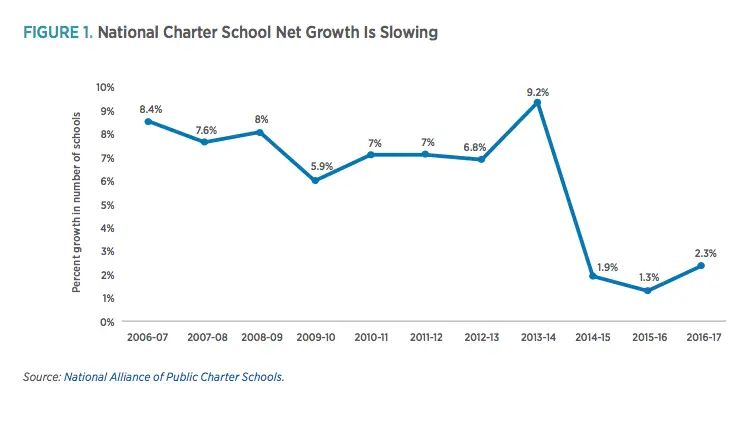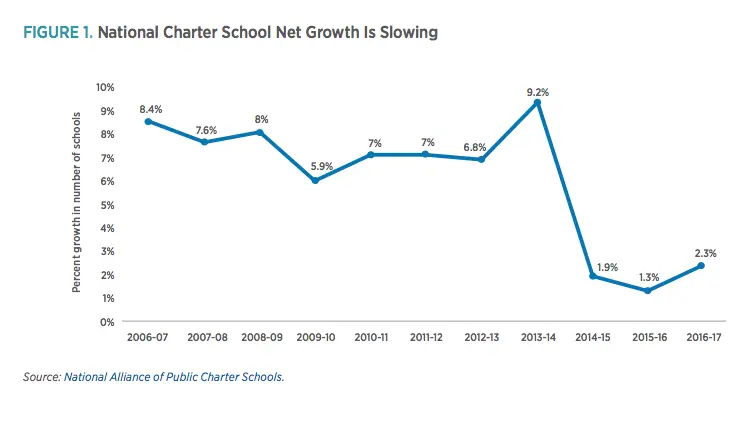Citing some recent CRPE work on charter school stagnation in the San Francisco Bay Area, Matthew Ladner has issued a grim assessment of the charter school movement’s health.
The slowdown in Northern California mirrors the nationwide trend. So do the underlying factors: butting heads within the charter school ecosystem, a lack of accessible facilities, and contentious politics. The question is whether this slowdown is a temporary condition—growing pains for a maturing movement—or a sign, in Ladner’s phrase, that the charter movement has become so decrepit it’s now “partially alive.”
There’s no question charter school growth seems to be hitting a wall. And efforts to charge through that wall—from a failed referendum in Massachusetts to successful charter-friendly legislation in Florida—seem only to have exacerbated the Manichean, and increasingly partisan, politics that ultimately hamper charter school growth. A minimum of 17 new governors will take office after the November elections. Few of these potential chief executives are talking openly or passionately about breathing new life into the charter school movement. The word “charter” never appears on the website of the charter school founder running to be Colorado’s next Democratic governor.
When it comes time to govern, these new state leaders and their teams will have to confront a number of challenges facing public education. Among them:
- College has never seemed more essential as a gateway to the middle class. It’s also never been harder to afford.
- A growing, bipartisan consensus is forming around the importance of career preparation—but neither high schools, nor higher education institutions, nor existing workforce programs have quite figured out how to support on-the-job learning alongside rigorous academics.
- School systems still struggle to adequately serve students with disabilities, non-native English speakers, and other complex learners.
- Politicians have embraced expanded early learning, but are struggling to figure out how to pay for universal public preschool, or to ensure large programs achieve their intended results.
- America’s childcare system has yet to accommodate the decades-old reality that nearly all parents work—putting pressure on schools, which are also workplaces, and on parents, whose work schedules seldom align with school hours.
- More researchers and educators are embracing the idea that trauma and other effects of generational poverty hinder students, but schools have struggled to integrate mental health and other services, which may already exist in their communities, that can help their students.
- Educators have embraced the promise of new ideas, like personalized learning, only to discover they’re laboring in a system that isn’t designed to support innovation.
- Teacher pay has remained stagnant in the wake of the Great Recession. Political pressure, which spilled into the public sphere during teacher strikes last spring, continues to build for more public education funding.
A revitalized charter school movement capable of proving Ladner wrong would draw inspiration from the Silicon Valley truism that today’s problems can lead to tomorrow’s startups. Focusing on these problems can help drive a new education reform agenda that can forge new political coalitions and reanimate the charter school movement.
Why doesn’t every major city in America have its own version of 4.0 Schools, which encourages path-breaking new startups, guides them through a process that includes testing their models in a small format, and nurtures those that succeed into full-fledged independent charter schools?
Similar incubators might encourage more educators of color to start their own schools, and to take risks experimenting with different approaches to career preparation, early-college programs, or better accommodations for children with special needs.
Helping to address these challenges won’t eliminate every barrier charter schools face. Facilities needs, for example, remain onerous in many places. But if the charter school movement can become part of the solution to big, unsolved problems in public education, rumors of its demise will prove exaggerated.





